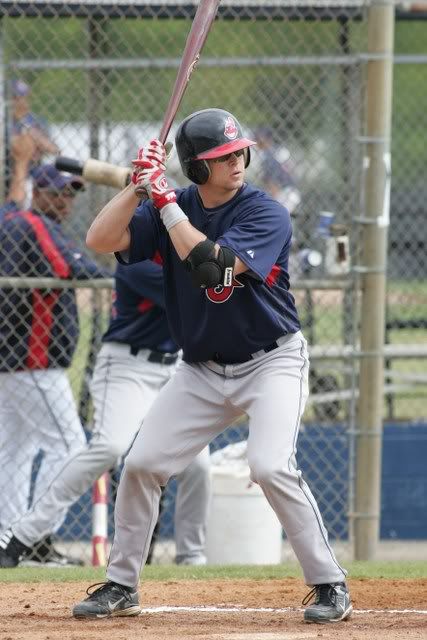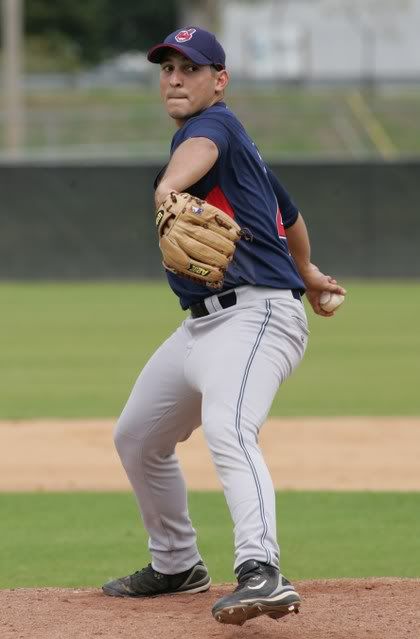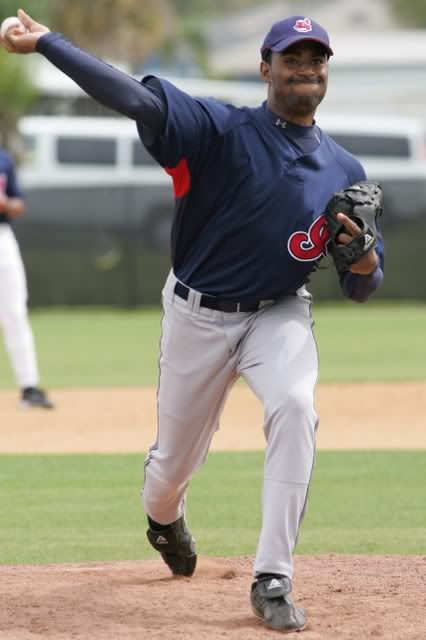 Indians Archive
Indians Archive  Minor Happenings: Head's Versatility Catching On
Minor Happenings: Head's Versatility Catching On
 This is a special edition of Minor Happenings, which today is just a recap of interviews I had with Jerad Head, Paolo Espino, and Carlton Smith while I was visiting the Indians advanced Class A affiliate Kinston in Woodbridge, Virginia a week ago.
This is a special edition of Minor Happenings, which today is just a recap of interviews I had with Jerad Head, Paolo Espino, and Carlton Smith while I was visiting the Indians advanced Class A affiliate Kinston in Woodbridge, Virginia a week ago.
Head's Versatility Catching On
Indians prospect Jerad Head is a jack-of-all-trades player where he not only can play anywhere in the infield and outfield, but after some work in the offseason and in spring training this year he has adding catching to his resume.
Head was signed as a non-drafted free agent in August 2005 out of Washburn University in Topeka, Kansas. Head originally signed on to play baseball at Kansas State University, but he eventually made the decision to go back to his hometown in Topeka to play baseball and basketball for the local university. Washburn University is a small school, Division II in fact, and Head was discovered and eventually signed by one of the Indians area scouts.
Since joining the Indians, Head's athleticism and versatility has been put on display from day one. He came in as an infielder in 2006, was moved to the outfield in 2007, and this year is now catching.
"I signed as a shortstop, and last year I moved to the outfield," said Head after taking batting practice before a recent game for advanced Single-A Kinston. "I'm real comfortable out there. Every spring training I have gone in as something different, from an infielder, to outfielder, and now as a catcher."
If the Indians keep this pattern up, maybe next spring Head will go into spring training as a pitcher. Of course this is only a joke, as Head laughed at the notion and said pitching is certainly not an option the Indians would ever consider. All kidding aside, Head is a player who can now play any position on the diamond.
Head was converted to catcher this offseason to improve his versatility and will get plenty of action  behind the plate at Kinston to get better at the position. It is a learning process for him, as prior to last fall in the Instructional League he had never caught before.
behind the plate at Kinston to get better at the position. It is a learning process for him, as prior to last fall in the Instructional League he had never caught before.
"This is the first time in my career that I have done it, from Little League all the way up to here," said Head. "I went to Instructional League last year and they kind of introduced it to me and in spring training this year as well. It's tough, especially when you get to this level with pitching. I've adapted to it pretty well though."
Catching is not for everybody. The position is very demanding physically and you have to be fundamentally sound. One of the early pitfalls Head has encountered with the transition to the catching position is getting his footwork down as it is a lot different than that of an infielder or outfielder.
"It's just the footwork," said Head when asked what has been the hardest thing to adjust to at the catching position. "The footwork is a lot different than in the infield or outfield. Also, just receiving the ball is different. Another one of the hardest things for me is my flexibility has not been there and as time goes on I am working at it."
Kinston manager Chris Tremie has seen Head through on his transition to his catching role. Tremie brings with him 14 years of catching experience as a professional, mostly in the minors, but will be a valuable asset for Head as he works to improve this season.
"Jerad is a good athlete," said Tremie. "It is a little different getting back there behind the plate, but it is going to take time. He is adjusting pretty well when he does get back there and doing good in drills, and he is still playing various other positions as well. So only time will tell, but he is a good athlete and works hard and we'll see what happens down the road."
As a hitter, Head has some good pop in his bat. In his debut season at rookie level Burlington in 2006 he hit .249 with 10 HR and 52 RBI in 59 games, and then last year at advanced Single-A Kinston he hit .266 with 5 HR and 32 RBI in 83 games. He has good pop, but he has struggled some with the plate discipline which is something he is still working on.
"I'm just trying to get more consistent," said Head. "Last year it was making sure I see and swing at better pitches, and I thought I got better at that as far as on-base percentage goes with drawing walks. I just have to watch more film on myself and study pitchers. It just comes down to working [even harder]."
Head's advancement as a hitter will be the key to him moving up the minor league ladder, and potentially on the Indians bench as a super utility player. He spent this past winter in the Nicaraguan Winter League and played third base the entire time. With his experience there and also being comfortable playing shortstop, second base, outfield and catcher, he knows his versatility is his ticket to the big leagues.
"I think it is," said Head. "Hopefully just being able to play every position [gets me there], but I am going to continue to go out there and keep working at it every day. Hopefully down the road this will pay off."
No Culture Shock For Espino
Kinston right-hander Paolo Espino had a night to forget in his Carolina League debut on Friday April 11th in Woodbridge, VA. In his Kinston debut, Espino went 4.1 innings and allowed ten runs on ten hits and two walks while only striking out one batter.
It was a rough first outing, but mostly could have been attributed to a long layoff. Espino was noticeably rusty as he had not thrown in a game for two weeks because of the layoff between spring training and the start of the season, and also because of several early season rainouts. After the game he even mentioned he was not comfortable and felt odd on the mound and that his pitches were off. His manager agreed.
"He did not have a real good feel for his curveball tonight," said Kinston manager Chris Tremie. "He battled, and was a little bit rusty, but he stayed out there and competed. He'll be better next time out."
Espino's next time out was certainly a better performance. This past Wednesday, Espino went five innings and allowed only two runs on four hits and a walk while striking out six. It was a much better performance from him, and a confidence builder going forward.
That said, the struggles in the early going for Espino are nothing compared to what he had to endure when he first came to the states in 2004. Espino was born in Panama City, Panama and lived there all his life until he moved to Florida early in 2004. He attended boarding school and lived on campus for high school until he graduated in 2006.
The hardest thing for Espino to adjust to was the culture shock of moving to a new country and also learning a new language. He did not speak any English when he first came to the states, but he immediately started learning the language when he came over. Even though he is still learning the language, he now speaks it very well and is comfortable using it in conversations and interviews such as this one.
"Yeah, the language barrier was hard," said Espino after his April 11th start. "But after I learned English I started feeling better. The cultures are different, but I got used to it and made friends real quick. Once I learned English it made things a lot easier and it was not that bad."
After being drafted in the 10th round of the 2006 Draft, Espino did not make his debut with the Indians until last season. In a surprising move, the Indians started him right off at Single-A Lake County and he responded well by going 4-5 with a 3.66 ERA in 33 appearances (13 starts) last year. He started the season in the backend of the Lake County bullpen, but after progressing nicely and going 2-1 with a 3.65 ERA and .213 batting average against in 20 appearances out of the bullpen he was moved into the starting rotation in June. He finished the year in the rotation, and was strong by going 2-4 with a 3.66 ERA and .243 batting average against in 13 starts.
The 21-year old Panamanian righty showcases a fastball that usually sits at 90 MPH and tops out at 92 MPH, and he compliments it with a good curveball and changeup. His best pitch is his changeup, although Espino says he has the most confidence in his curveball. All three of his pitches grade out as at least average with the chance to be above average pitches.
Espino likes what he accomplished last season, but feels there is still much room for improvement.
"I feel good about last year," said Espino. "Spending the whole season in Lake County I think made me a lot better. I learned a lot as I used to keep the ball up and am working on keeping my fastball down in the zone more. I am small, so I have to throw the ball from up top and downhill. It is something I have to keep working on and if I do that I will be a lot better."
Because of Espino's lack of size (5'10" 190 pounds), he most likely projects as a reliever down the road. But, while he is lacking in size, there is absolutely no lack of heart. He goes right after hitters, works hard, and ultimately wants to stay in the starting rotation as long as he can.
"I am starting right now and hopefully it stays like that as I like it the most," said Espino. "But I do like the opportunity and wherever they put me I will try to do my best."
Smith Moves Up A Level
After two years in Single-A Lake County, right-handed pitcher Carlton Smith has moved up the minor league ladder to advanced Single-A Kinston this season. Smith is now part of a solid, young group of right-handers in the Kinston rotation.
The Indians selected Smith in the 21st round of the 2004 Draft out of high school (NJ). When the Indians drafted Smith, his older brother Corey Smith was still in the organization. Smith throws a fastball which hovers around 92-93 MPH and he has gotten it up to 95 MPH in the past, and compliments his fastball with an above average slider and is still working on developing a changeup. Last year at Lake County, Smith was 11-6 with a 4.22 ERA in 31 games (18 starts), and was tied for fourth in the Indians system in wins and tenth in ERA.
Most may remember Corey as the former #1 prospect in the Indians organization a few years back, but he was plagued with issues making consistent contact at the plate and struggled defensively at third base. The Indians eventually traded Corey to the San Diego Padres in February 2005, but since Carlton did not sign until May of 2005 as a draft-and-follow player, the two brothers never were united in the Indians organization at the same time.
Corey is now in the Angels system and Carlton is still with the Indians, but even though the two were never in the organization at the same time the two have spent plenty of time together in the past when Corey was with the Indians. In high school, Carlton would often visit Corey wherever he was at to learn about the experience because baseball was something he dreamed of doing someday.
"Corey basically told me to just stay focused," said the younger Smith after a game in Woodbridge, Virginia a week back. "I got to live what it is like through him basically growing up because he got drafted in 2000 and I was in middle school. And every year I would go to where he was at and hang out with him and I got to see what it was like because [playing baseball] was something I wanted to do as well."
After signing with the Indians, Smith debuted in 2005 at rookie level Burlington and went 0-2 with a 4.76 ERA in nine starts. He followed that up by going right to Single-A Lake County in 2006 and was off to a solid start at 3-3 with a 4.06 ERA in 11 starts, but his season ended prematurely because he had to be shut down after what he described as a tear of his UCL. Last year, Smith went back to Lake County and by the conclusion of the season he felt better and completely healthy.
Right now, Smith is just happy to have an opportunity to pursue his dream of playing baseball in the major leagues someday. As with any pitcher, Smith has some areas he is focused on improving and working on all season.
"Carlton has shown signs of improvement on the things he is working on," said Kinston manager Chris Tremie. "[Those things being] the ability to repeat the delivery, command the fastball, and to throw a secondary pitch for a strike consistently."
Smith agrees with his manager's assessment.
"I'm just trying to build my pitches better," said Smith. "I need to make them more in the strike zone so that when I do get two strikes I'll get that batter to chase. I also need to make myself an all around better player, person and teammate."
While Smith is continuing to improve, the early returns have not been favorable as in three starts for Kinston he is 0-1 with an 8.10 ERA.
All photos courtesy of Ken Carr

- NBA Announces 2013-2014 Schedule
- Browns Ink Sharknado
- Sharknado A No-Show For Rookie Camp
- Trent Richardson Out Until Training Camp
- Browns Sign Brandon Jackson
- Carrasco Suspended Eight Games
- Browns Add to Wide Receiver Depth with David Nelson
- Browns Need to Learn from Past Draft Mistakes
- Browns Release Chris Gocong and Usama Young
- Browns Missing on Grimes Disappointing, But Not The End
The TCF Forums
- The 2014 Offseason Thread
skatingtripods (Tuesday, January 21 2014 11:52 AM) - Official- Browns Coach Search/Rumors
Nicastro13 (Tuesday, January 21 2014 11:45 AM) - Chris Grant's first 3 drafts
Kingpin74 (Tuesday, January 21 2014 10:13 AM) - 2015 Recruiting
furls (Tuesday, January 21 2014 6:57 AM) - Mike Brown
YahooFanChicago (Monday, January 20 2014 11:15 PM) - Movies coming out
HoodooMan (Monday, January 20 2014 9:34 PM) - 2014 Hoops Hockey Hijinx
jpd1224 (Monday, January 20 2014 4:44 PM) - 2014 Recruiting
jclvd_23 (Monday, January 20 2014 2:26 PM) - Wish List - #4 Pick
Hikohadon (Monday, January 20 2014 1:26 PM) - #1 overall pick Anthony Bennett
TouchEmAllTime (Sunday, January 19 2014 1:28 PM)



